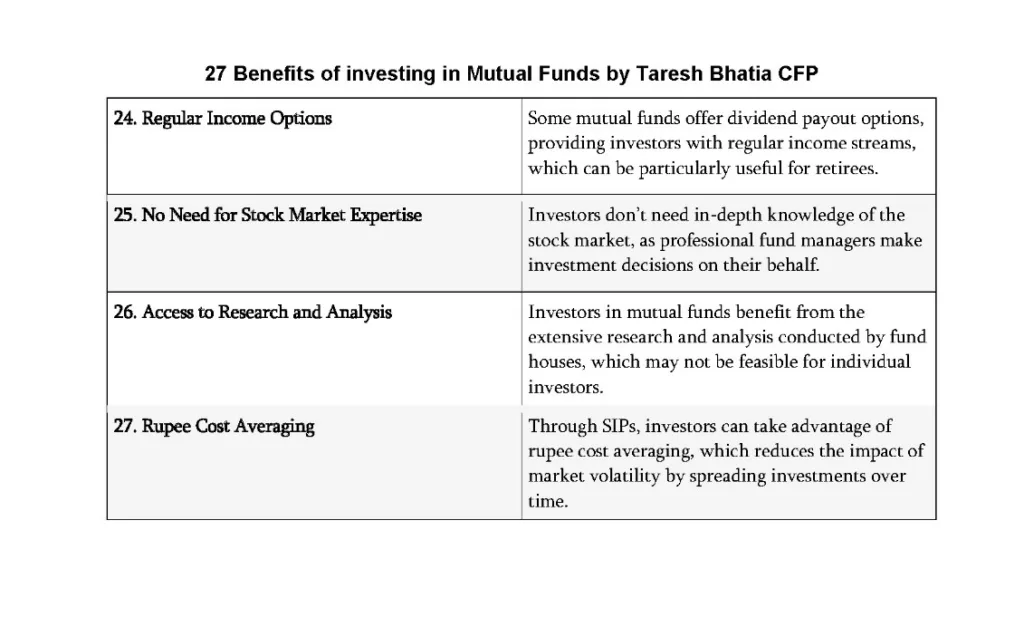In the ever-evolving financial landscape, mutual funds have proven to be a reliable and efficient investment vehicle for wealth creation. As we approach 2024, selecting the right mutual fund investing strategies becomes more crucial than ever. Whether you are a novice investor or someone with years of experience, understanding how to align your investment choices with your personal financial goals is key to maximizing returns. In this article, we will dive deep into the critical factors you need to consider when choosing mutual funds, how to develop a sound investment strategy, and what specific categories of funds might offer the best potential returns in the coming year.
1. How Do I Choose the Right Mutual Fund?

Choosing the right mutual fund is not just about picking the fund with the highest past returns; it’s about selecting a fund that aligns with your financial situation, goals, and risk tolerance. Here are some key factors to consider:
Age
Your age plays a significant role in determining your investment horizon and risk appetite. For younger investors, there is typically a longer time horizon to recover from potential losses, making equity mutual funds a viable option due to their potential for higher returns. On the other hand, if you are nearing retirement, a more conservative approach with a focus on preserving capital might be appropriate, possibly leaning towards debt funds.
Risk Appetite
Understanding your risk tolerance is crucial. If you are comfortable with the ups and downs of the market, equity funds, especially those in the small-cap and mid-cap categories, might suit your portfolio. Conversely, if you prefer stability and less volatility, debt funds, or balanced funds that invest in both equities and fixed income, might be more suitable.
Income
Your income level impacts how much you can regularly invest. For those with higher disposable income, equity-heavy portfolios with a Systematic Investment Plan (SIP) approach might be ideal for wealth creation. If your income is more moderate, diversifying into a mix of equity and debt funds can help balance risk while still allowing for growth.
Financial Goals
Your investment goals dictate your fund choices. Are you saving for retirement, a child’s education, or a major purchase? Your goals will determine whether you need a growth-focused fund or one that provides stability and income. For example, if your goal is long-term wealth accumulation, equity funds, particularly in the small-cap and multi-cap categories, might be your best bet.
Market Context
Understanding the current economic environment is also important. In a bullish market, equity funds generally perform well, while in a bearish or uncertain market, debt funds might offer more security. Keeping an eye on market trends and economic indicators can help you adjust your strategy to maximize returns.
How to Develop a Mutual Fund Strategy
Once you have a clear understanding of your financial profile, you can begin to develop a mutual fund strategy that aligns with your goals.
2. Remember: These Are Not Recommendations
Before diving into the specific strategies, it’s essential to understand that the decisions you make regarding mutual funds must be your own. The information provided here is to guide you, but it should not be taken as financial advice. Always do your own research or consult with a financial advisor to ensure that the strategies you adopt are appropriate for your situation.
3. My Selection Criteria for Mutual Funds

When it comes to selecting mutual funds, I follow a specific set of criteria that helps in identifying funds that align with long-term wealth creation:
Ratio Study
Analyzing the financial ratios of mutual funds is crucial. This includes looking at the expense ratio, which indicates the cost of managing the fund relative to its assets. A lower expense ratio can significantly impact your net returns, especially over a long period.
Preference for Closed-Ended Funds
Closed-ended funds have a fixed maturity date and a fixed number of units. They are less liquid than open-ended funds but can offer higher returns due to their structured investment period. These funds often invest in less liquid assets, which might yield higher returns but require a long-term commitment.
Regular Plans Over Direct Plans
While direct plans have lower expense ratios since they don’t include distributor commissions, I often prefer regular plans. Regular plans come with the added benefit of professional management and advisory services, which can be particularly valuable for less experienced investors or those who prefer a hands-off approach.
Not Based Solely on Returns
While past performance is an indicator, it should not be the sole criterion. I evaluate funds based on their consistency, the strategy of the fund manager, the quality of the assets they invest in, and how they perform relative to their benchmarks and peers.
4. Investing for the Long Term: The Power of Compounding

For those who are investing with a long-term horizon in mind, certain categories of mutual funds have historically provided substantial growth. Let’s explore some of these categories:
Small Cap Funds
Small-cap funds invest in companies with smaller market capitalization. These companies have the potential for significant growth, and small-cap funds can deliver higher returns over the long term. For example, if you invest ₹10,000 per month in a small-cap fund with an assumed 22% CAGR for 10 years, your investment could grow to ₹43,58,642. By increasing your investment by 10% annually, you could see your wealth grow to ₹57,86,165.
- CAGR: 18%-20%
- Potential Growth: Doubling of investment in approximately 3.5 years
- Alpha: 5%+
Multi Cap Funds
Multi-cap funds invest across large, mid, and small-cap stocks, providing diversification and balanced growth. These funds are less risky than small-cap funds but still offer substantial returns.
- CAGR: 18%+
- Potential Growth: If you invest ₹10,000 monthly for 10 years at an 18% CAGR, your investment could grow to ₹33,62,575. With a 10% annual step-up, it could reach ₹46,03,901.
- Alpha: 3%+
Flexi Cap Funds
Flexi cap funds are versatile, allowing the fund manager to shift investments between large, mid, and small-cap stocks based on market conditions. This flexibility can lead to superior returns in varying market environments.
- CAGR: 18%-22%
- Potential Growth: A ₹10,000 monthly investment for 10 years at 18% CAGR could result in a corpus of ₹33,62,575, growing to ₹46,03,901 with a 10% annual step-up.
- Alpha: 4%-6%+

Large and Midcap Funds
Large and midcap funds offer a blend of stability and growth potential by investing in both large, established companies and mid-sized companies with growth potential.
- CAGR: 25%+
- Potential Growth: A ₹10,000 monthly investment for 10 years at a 25% CAGR could grow to ₹53,28,047, and with a 10% annual step-up, it could reach ₹69,18,917.
- Alpha: 4%+
Index Funds
Index funds are passive funds that aim to replicate the performance of a specific index, such as the Nifty 50. These funds typically have lower expense ratios and are suitable for investors looking for steady, long-term growth.
- Average Return: 12%-15%
- Potential Growth: Index funds provide moderate growth but with lower risk compared to actively managed funds.
ELSS (Equity-Linked Savings Scheme)
ELSS funds are tax-saving mutual funds that invest primarily in equities. These funds come with a lock-in period of three years and offer tax benefits under Section 80C of the Income Tax Act.
- CAGR: 20%-22%
- Potential Growth: A ₹10,000 monthly investment over 10 years could grow to ₹38,23,636 with monthly compounding at 20%. This is a substantial growth compared to traditional savings options like PPF, which might grow to ₹18,94,711 at 8.5% p.a.
- Alpha: 5%+
5. Age-Wise and Income-Wise Allocation Suggestions

Your age and income are critical factors in determining how you should allocate your investments across different types of mutual funds. Below is a suggestion matrix based on these factors:
For Younger Investors (20s and 30s)
- Equity Exposure: 70%-80% (Small Cap, Multi Cap, Flexi Cap Funds)
- Debt Exposure: 20%-30% (Debt Funds, Liquid Funds)
- Objective: Aggressive growth with a higher risk appetite.
For Middle-Aged Investors (40s and 50s)
- Equity Exposure: 50%-60% (Large and Midcap, Index Funds, ELSS)
- Debt Exposure: 40%-50% (Debt Funds, Balanced Funds)
- Objective: Balanced growth with moderate risk.
For Pre-Retirement Investors (60s and Above)
- Equity Exposure: 20%-30% (Large Cap, ELSS)
- Debt Exposure: 70%-80% (Gilt Funds, Liquid Funds)
- Objective: Capital preservation with low risk.
6. Guiding Principles for Mutual Fund Investing
Adhering to guiding principles can help you stay disciplined and make informed investment decisions:
Stay Invested for the Long Term

The power of compounding works best over long periods. Avoid the temptation to exit during market downturns. Staying invested through market cycles can lead to significant wealth creation.
Diversify Your Portfolio
Diversification helps in spreading risk across various asset classes. Don’t put all your eggs in one basket; instead, invest in a mix of equity, debt, and hybrid funds.
Regular Portfolio Review
Conduct regular reviews of your portfolio to ensure it aligns with your financial goals. Rebalance your portfolio as needed to maintain your desired asset allocation.
Avoid Timing the Market

Timing the market is difficult and often leads to missed opportunities. Focus on time in the market rather than timing the market.
Also read: Why Investing in Mutual Funds is Better Than Property in India: 21 Key Reasons
Tax Efficiency
Consider the tax implications of your investments. Use strategies like tax harvesting to optimize your tax liabilities and maximize post-tax returns.



Conclusion: Building Wealth Through Strategic Mutual Fund Investing
Investing in mutual funds is a powerful way to achieve financial freedom and build wealth over time. By understanding your financial goals, risk appetite, and the various types of mutual funds available, you can develop a strategy that aligns with your needs. As we head into 2024, the financial landscape presents both challenges and opportunities. Adopting a disciplined, long-term approach to mutual fund investing can help you navigate these changes and maximize your returns.
If you found this guide helpful, I encourage you to explore more of my content on financial planning and investing. Don’t forget to subscribe to my blog for regular updates and insights on personal finance. Together, we can build a wealthy, wise, and rich life.
The author of this article, Taresh Bhatia, is a Certified Financial Planner® and advocate for female empowerment. For more information and personalized financial guidance, please contact taresh@tareshbhatia.com
He has authored an Amazon best seller-“The Richness Principles”. He is the Coach and founder of The Richness Academy, an online coaching courses forum. This article serves educational purposes only and does not constitute financial advice. Consultation with a qualified financial professional is recommended before making any investment decisions. An educational purpose article only and not any advice whatsoever.
©️2025: All Rights Reserved. Taresh Bhatia. Certified Financial Planner®
Subscribe Now for Upcoming Blogs!
📢 Join free live webinar —
Couple Finance Formula™ Register here




